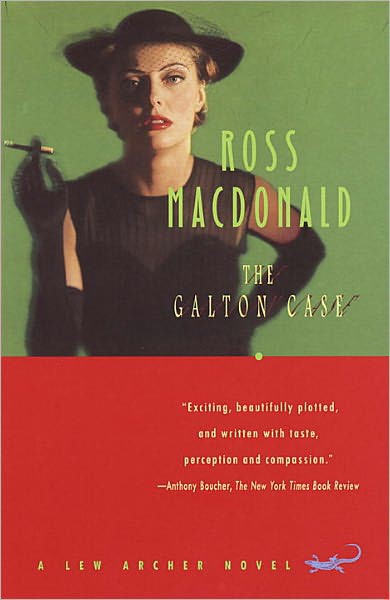
The Galton Case PDF
Preview The Galton Case
The Barnes & Noble ReviewIn 1959, Ross Macdonald published what is generally considered his breakthrough novel, The Galton Case, a complex, psychologically acute account of the search for personal identity, and of the destructive power of the unresolved past. Macdonald ultimately established himself as one of three dominant forces in the development of the modern private-eye novel. The other two, of course, were Dashiell Hammett, who virtually invented the form, and Raymond Chandler, who brought wit, attitude, and a highly evolved sense of language, elevating detective fiction to a whole new level. Macdonald -- the pseudonym of California-born novelist Kenneth Millar -- was the direct literary descendent of these two titans, and he worked comfortably within that inherited tradition for a number of years, producing several excellent, if generic, novels featuring private investigator Lew Archer. (Archer, incidentally, was named after Sam Spade s partner, Miles Archer, who is murdered in the opening pages of The Maltese Falcon.) The Galton Case was Macdonald s 13th novel, and his 8th entry in the Lew Archer series. It also represented his first fictional attempt to engage certain sensitive areas from his own unresolved past. Foremost among these was the sense of abandonment that resulted from his parents' divorce, which occurred when he was four years old. In the aftermath of that divorce, the young Ken Millar lived a fatherless, rootless existence that left him troubled, vulnerable, and emotionally scarred. Using the distancing device of the detective story -- which he once referred to as "a welder s mask enabling both writer and reader to handle dangerously hot materials" -- Millar/Macdonald created, in The Galton Case, a classic mystery that contains within itself a thinly veiled spiritual autobiography.As the novel opens, Lew Archer has just been hired by Gordon Sable, a Santa Teresa lawyer, to track down the long-lost son of his wealthiest client, the imperious Maria Galton. Her son, Anthony Galton, had disappeared more than 20 years before, following a bitter family argument over the suitability of his new, and very pregnant, wife. Now that she is old, frail, and close to death, Maria Galton is determined to reconcile with her son, and to locate the grandchild she has never met. Archer, certain that too much time has passed and that his chances of success are slight, reluctantly agrees to investigate.Contrary to expectations, he gets immediate -- and astonishing -- results. First, he discovers the existence of a decapitated skeleton that appears to be the mortal remains of Anthony Galton. At the same time, he meets an orphaned young man -- "John Brown Jr." -- whose quest for identity forms the psychological heart of this novel. Brown bears a striking resemblance to the deceased Anthony Galton and possesses a birth certificate indicating that he just might be the long-lost Galton heir. Archer, wary and only half convinced, presents the young man to his putative grandmother, who welcomes him with open arms and pronounces the investigation over.But, of course, it isn t over. The Galton family physician, who is himself unconvinced of Brown s legitimacy, hires Archer to look into the young man s background. This new stage of the investigation takes Archer on a journey through John Brown s past, carrying him from California to Ann Arbor, Michigan, and from Michigan to Canada, as he searches for proof of what he now believes is a carefully constructed act of imposture. Along the way, his investigation intersects with an apparently unrelated murder involving Gordon Sable and his emotionally damaged wife, with the violent depredations of a Nevada gangster, and with the long-buried secret behind the 20-year-old murder of Anthony Galton. In the final pages, all of the elements, past and present, come together in a climactic revelation, and John Brown Jr. s traumatic history stands fully, painfully revealed. The Galton Case created a kind of template for the 10 Lew Archer novels that would eventually follow. That template, which describes a process roughly analogous to that of psychoanalysis, invariably involved a number of common elements: a troubled family, torn apart by a combination of internal pressures and external events; a crime (or crimes) of violence; and an ancient, festering secret whose resolution is essential to the process of healing, and to the ultimate resolution of present-day dilemmas. This primal drama, embodied for the first time in the story of John Brown/John Galton and his search for his personal heritage, represents Macdonald s major contribution to his chosen genre. More than any of his predecessors -- including Hammett and Chandler -- he understood both the complexities and the vulnerabilities of human psychology and brought that understanding to bear in a unique, irreplaceable series of novels that broke new ground, that broadened -- and deepened -- the emotional territory available to the writers who followed in his wake.(Bill Sheehan)Bill Sheehan reviews horror, suspense, and science fiction for Cemetery Dance, The New York Review of Science Fiction, and other publications. His book-length critical study of the fiction of Peter Straub, At the Foot of the Story Tree, has been published by Subterranean Press (www.subterraneanpress.com).
